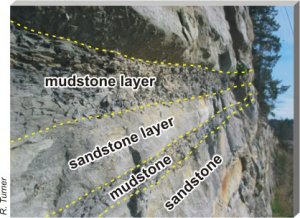YEC has problems with rock records? YEC is indefensible? I am not going to get off the cellular and genetics issues but this post is a quick reminder.
Polystrates are not our problem, they are for Darwinists. So are out-of-order fossils and rock layers, megebreccias and an increasing number of "Lazarus" organisms being found alive much as they were just before the flood.
We find extensive fossil “graveyards” and exquisitely preserved fossils. For example, billions of nautiloid fossils are found in a layer within the Redwall Limestone of Grand Canyon. This layer was deposited catastrophically by a massive flow of sediment (mostly lime sand). The chalk and coal beds of Europe and the United States, and the fish, ichthyosaurs, insects, and other fossils all around the world, testify of catastrophic destruction and burial.

Borrowing wording in some cases from Andrew Dennis:
We find fossils of sea creatures in rock layers that cover all the continents. For example, most of the rock layers in the walls of Grand Canyon (more than a mile above sea level) contain marine fossils. Fossilized shellfish are even found in the Himalayas. Rocks do not normally bend; they break because they are hard and brittle. But in many places we find whole sequences of strata that were bent without fracturing, indicating that all the rock layers were rapidly deposited and folded while still wet and pliable before final hardening. For example, the Tapeats Sandstone in Grand Canyon is folded at a right angle (90°) without evidence of breaking. Yet this folding could only have occurred after the rest of the layers had been deposited, supposedly over “480 million years,” while the Tapeats Sandstone remained wet and pliable.

We find rock layers that can be traced all the way across continents—even between continents—and physical features in those strata indicate they were deposited rapidly. The Tapeats Sandstone and Redwall Limestone of Grand Canyon can be traced across the entire United States, up into Canada, and even across the Atlantic Ocean to England. The chalk beds of England (the white cliffs of Dover) can be traced across Europe into the Middle East and are also found in the Midwest of the United States and in Western Australia. Inclined (sloping) layers within the Coconino Sandstone of Grand Canyon are testimony to 10,000 cubic miles of sand being deposited by huge water currents within days. Directional sorting is often found in the fossil record.
The flood provided an excellent environment for the required quick burial of fossils. Preservation of complete animal or plant remains requires quick burial by sediments. Dead animals or plants which are not buried quickly decompose or are eaten before they can become preserved. Fossils are often found buried in hundreds of feet of solid, unbroken rock strata. Flood geologists infer that those rock strata were laid down in a relatively quick period, burying the organisms before they had time to decompose.
Oh, yes, and as we study the cell we see that rapid speciation is a design feature of the organism and thus we have many varieties of animals coming from the kinds that were extant after the flood. Have a great weekend!!!

